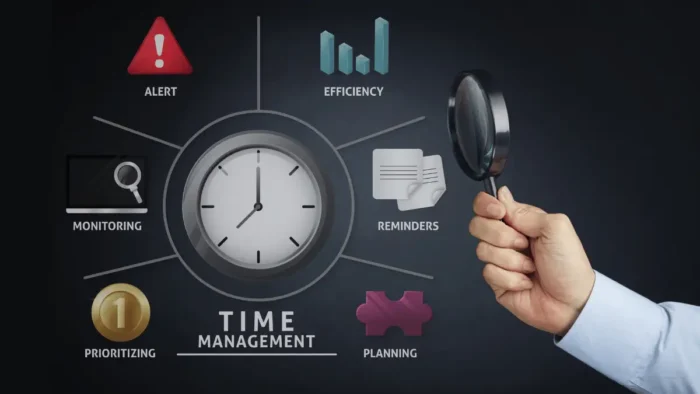Time, for everyone, including entrepreneurs, is the most valuable resource. It’s the currency in which we trade to achieve our goals, scale our businesses, and live a balanced life. However, in our busy work environments and with the strict entrepreneurial lifestyle, managing time can be a daunting task. It’s easy to feel overextended, unclear about what to focus on, and, eventually, unproductive. This is where the time management matrix comes in as your organizational compass, guiding you toward optimal productivity.
As a part of my efforts to increase productivity, I need to prioritize my tasks. A time management matrix is a great tool for this purpose. I want to show you how to use a time management matrix to become more productive and complete all your critical tasks.
In this guide, we’ll explore the time management matrix. We’ll break it down into its quadrants and show you how to use it to accomplish your most important tasks. You’ll also discover how to improve your strategic planning, simplify your workflows, and still have time for rest and recharging.
Why is Time Management so Important?
The question that I always try to answer about each thing that needs to be done from my side is about the importance of that thing. I always use importance to prioritize tasks. If it is more important, then the priority will be higher.
Many years ago, as a student working on a master’s degree in the bookstore, I found a book from Stephen R. Covey titled First Things First. This one was among 15 other books I purchased that day in that bookstore. There, for the first time, I learn more about prioritizing and doing the first things first, with the help of a framework in the form of the 2×2 matrix (time management matrix).
But, before we discuss the time management matrix, why should time management be high on your agenda?
Picture this – what if you could spend your time effectively on tasks that matter? Imagine the weight lifted from your shoulders, the goals you could achieve, and the quality of work you could produce.
Time management isn’t just about ticking off tasks on your to-do list; it’s about perfecting your priorities to achieve success within less time and with less stress.
If you, as an entrepreneur, succeed in mastering time management, you will achieve several essential benefits:
- You will increase your productivity. Yes, your productivity will increase when you focus on what matters most for you and your business.
- Less stress and overwhelming. With the right time management approach, you will spend less time on trivial things, which means more time for strategic vision and problem-solving.
- Better focus. Clear time management helps you focus on one task at a time, leading to better-quality work and decisions you make.
- Goal achievement. Efficiently working on tasks that drive your business forward brings you closer to your strategic goals.
When you start working on your time management skills, it’s all about understanding the tool that opens these benefits – the time management matrix.
Why Do You Need Prioritization?
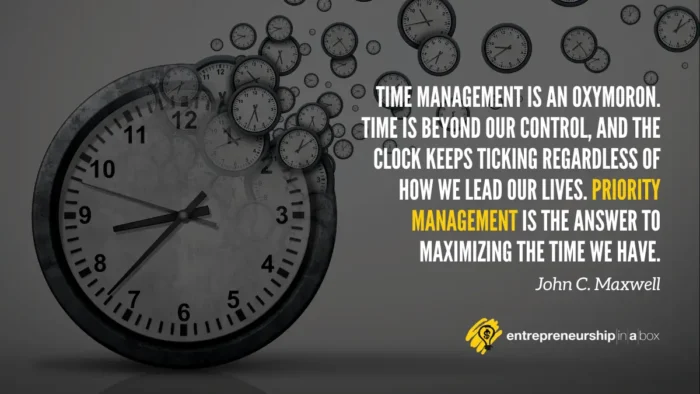
Entrepreneurs are in a position where they always try to find better solutions for their workload. Business needs big investments of entrepreneurial efforts, knowledge, money, and time.
As an entrepreneur, there are many ideas, things, and tasks around you. You need to start doing something on that list, and you also need to say no to many things if you want to stay on the right road.
I like to have many things I need to do, but my time and priorities are not always as I like to be. I need to decide to trash many things that I want to do, but that doesn’t mean it will be completely removed from possible work. Instead of really deleting stuff, I will put them somewhere for future review and possible decisions about them. So, in such a way, I try to prioritize tasks and work on important tasks first.
Here is a helpful quote about these types of problems.

What is the Time Management Matrix?
The time management matrix is also called the Eisenhower matrix, a method used by former US President Dwight D. Eisenhower, which he used for task prioritization and being more productive in his office. Eisenhower realized that not all tasks had the same level of urgency and importance, so he developed a system to categorize them accordingly. This system was later known as the Eisenhower matrix.
Later, management consultant Stephen R. Covey explains the time management matrix (sometimes called the Covey time management matrix) as a two-by-two box that will help you categorize tasks into four categories based on their urgency and importance. This tool helps you make challenging, strategic choices about what and when to start doing critical tasks, postponing, deleting, and delegating tasks.
So, the time management matrix gives you four quadrants, which can be used in prioritization and deciding about essential tasks you will need to do, tasks that can be delegated, and tasks you can drop out. In addition to this decision, you can also decide what can be a part of your delegation process.
Related: Real-life Organizational Decision-Making Examples
Here is the matrix with all four quadrants that I will explain to help you categorize tasks based on importance and urgency.
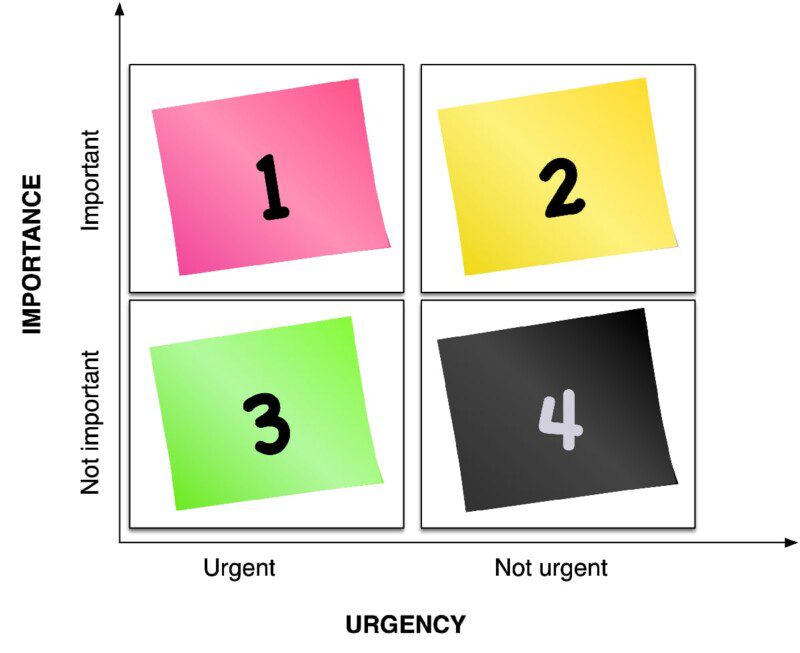
The Meaning of Time Management Matrix Quadrants
Quadrant 1: Important and Urgent Tasks
This quadrant of the time management matrix features urgent and important tasks. They require immediate attention and align with your critical goals and values. For many, this is where most of their time is spent.
Let’s think about the important and urgent tasks. These tasks are important for you and, simultaneously, urgent and require immediate attention to be done as quickly as possible. They should be your first priority before everything else on your list of tasks. These types of tasks need to be done today or tomorrow, depending on the time when you prepare yourself for your daily activities.
For example, in this quadrant of the time management matrix are tasks such as already scheduled meetings with your customers, improvements that you need to implement, a project that solves a big problem in your company, etc.
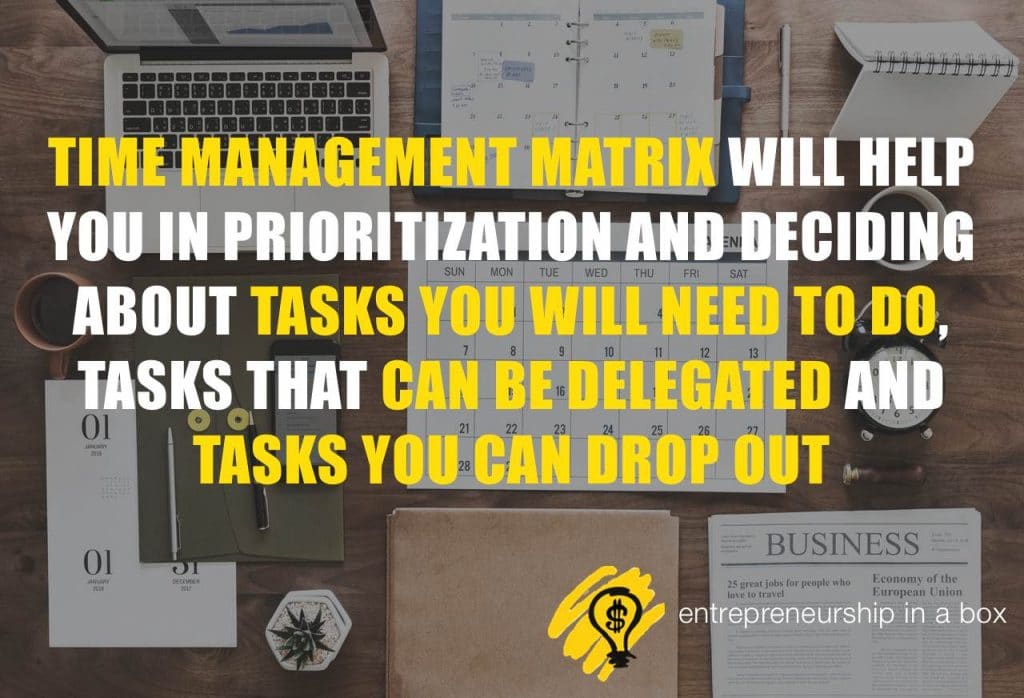
Quadrant 2: Important But Not Urgent Tasks
These tasks in the second quadrant of the time management matrix are important but not urgent duties. They often relate to your long-term goals and strategic objectives but don’t require immediate implementation. It’s your area for vision and planning.
This quadrant will have tasks that are important to you, but you can schedule them for some time in the future. You don’t need to jump directly to work on them today, but they will be something of your focus when you finish all first-priority tasks (Quadrant 1).
For example, planning a project can be part of this quadrant because you can always start planning tomorrow.
Each task in this quadrant of this task management tool represents areas where you can focus your efforts for strategic growth and operational improvement without the pressure of immediate deadlines.
Quadrant 3: Urgent But Not Important

Tasks in this section are urgent but insignificant. They spend their time for little reward, often related to the agendas of others or common distractions.
Can you have something urgent but not important? These tasks should be your low-priority tasks because they are unimportant to you, even if they are urgent. You will not lose anything if you do them later when you’ve done the highest priority tasks from the first and second quadrants of the time management matrix.
For example, answering an email that is not so important, even if it has an urgent label on the subject line from a sender, is not your first priority. It is the first priority for the sender.
Entrepreneurial tasks that fall into the third quadrant of a Covey time management matrix are often tricky because they appear to demand immediate attention while offering little long-term value or progress toward your business goals.
Quadrant 4: Not Urgent and Not Important

Finally, we have the tasks that are neither important nor urgent. They’re often time wasters – activities you should minimize or totally eliminate from your schedule.
Why will something not urgent and not important will be on your list of tasks? You need to drop them off. Don’t waste your time on such tasks.
Entrepreneurial tasks that often fall into the fourth quadrant of the time management matrix, being neither urgent nor important, typically represent the lowest value on your priority list. Recognizing and minimizing these activities can significantly enhance productivity and save valuable time for more important tasks.
Time Management Matrix Examples
Q1: Urgent and Important Examples
Regarding the tasks with the highest priority here, all tasks related to deadline-driven projects, such as last-minute pitch proposals or crisis management, would be in this quadrant.
Here are five categories of your entrepreneurial tasks that will need to be part of the first quadrant of the time management matrix:
- Client emergencies. When a client faces an urgent issue that may affect their life or business and, because of that, yours, addressing this becomes the highest priority. The significance lies in maintaining trust, a strong client relationship, and potential business impacts.
- Product or service failure. Any unexpected breakdown or failure in your core offering that affects your customers’ experience needs immediate resolution. These critical tasks directly influence your business’s reputation and customer satisfaction.
- Compliance and legal deadlines. Deadlines related to legal or compliance requirements must be met without delay if you want to avoid penalties, legal issues, or operational disruptions. They are non-negotiable and can have long-term consequences on your business’s legality and ethical standing.
- Critical financial obligations. Important tasks also include addressing cash flow deficits, urgent payroll needs, or debt deadlines. They hold the highest importance due to their immediate impact on your company’s financial health and operational capability.
- Emergency staff issues. Situations such as dealing with sudden significant staff absences or resolving conflicts among key team members are important and urgent. The urgency and importance are clear, as they can directly affect your team’s morale and productivity, impacting your overall business performance.
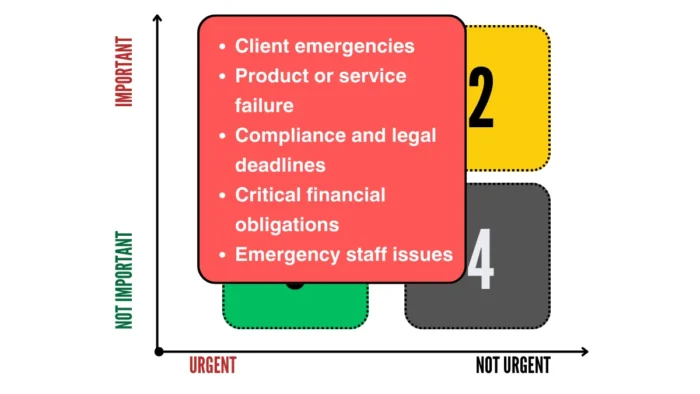
Each of these tasks requires immediate attention and is closely linked to the survival and sustainability of your business. Their placement in quadrant one on a Stephen Covey time management matrix emphasizes focusing on areas that cannot be delayed or delegated without potential negative consequences for your business and its stakeholders.
Q2: Not Urgent and Important Tasks Examples
The second quadrant of this productivity tool covers examples that include strategic planning, relationship-building, personal development, and business improvement.
- Strategic business planning. Planning is crucial for setting long-term business goals and determining the best course for your small business. Strategic planning tasks are important for business growth but don’t usually require a high level of urgency, allowing you to be part of the future consideration and in-depth analysis.
- Professional development. Investing time in your own skills and knowledge or that of your teams isn’t urgently required but is important for staying competitive and innovative.
- Networking. Building and maintaining professional relationships is essential for your long-term business success. Networking activities are important for creating opportunities but are not urgent activities and can be planned around more immediate tasks.
- Market research. Researching market trends, customer needs, and competitors is critical for informed decision-making. Still, they don’t need to be done urgently unless driven by a specific project or opportunity timeline.
- Process improvement initiatives. Identifying and implementing ways to improve operational efficiency is key to reducing costs and enhancing productivity. These tasks are important for long-term success but typically are not urgent, allowing time for careful evaluation and planning.
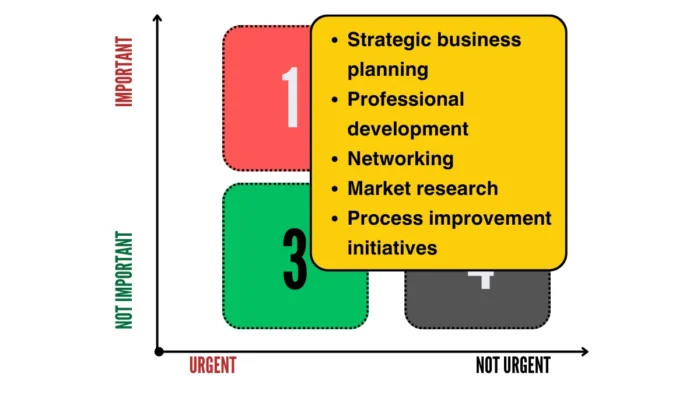
Q3: Urgent and Not Important Examples
Frequent schedule disruptions, unnecessary meetings, and most phone calls are examples of tasks in this quadrant.
Here are a few examples of such tasks:
- Responding to non-essential emails. Constantly checking and replying to emails can seem urgent due to the immediacy of digital communication. However, not all emails require an immediate response, especially those that do not contribute to your immediate business objectives or growth.
- Unscheduled meetings. Meetings that pop up without prior planning often fall into this category, especially if they are about topics that could be resolved more efficiently, such as a quick email or message. Unscheduled meetings can disrupt your current workflow and take time away from more important tasks.
- Social media notifications. While maintaining an online presence is crucial for your business today, reacting to every social media notification is not. These can create a false sense of urgency due to their real-time nature, but they rarely impact your business’s core operations or strategic goals.
- Frequent checking of business key performance indicators. While staying informed about your business’s performance is essential, obsessively checking analytics or sales data throughout the day is unnecessary. This task can be scheduled for specific, less intrusive times to ensure a comprehensive and thoughtful review process.
- Minor technical issues. Technical issues that do not significantly impact your business operations or customer experience often fall into this quadrant. While they may seem urgent at the moment, they can typically wait until high-priority tasks are completed.
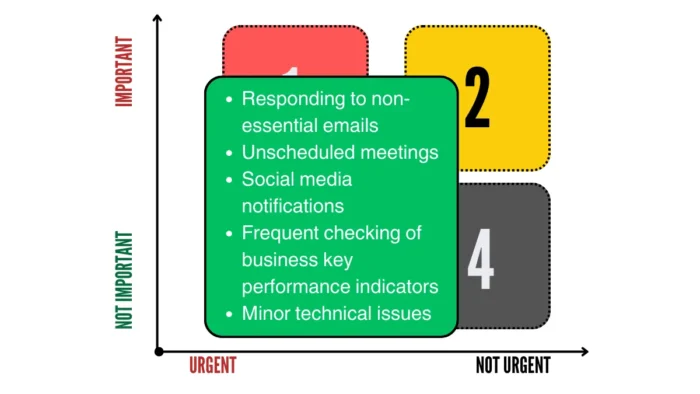
While they might press for immediate work, each task rarely contributes significantly to your broader, strategic business goals. When you recognize and prioritize tasks into this quadrant, it helps you identify areas where they may be allocating resources inefficiently.
Q4: Not Urgent & Not Important
Often, mindless social media scrolling, needless emails, and excessive personal phone use fall under this category.
Here are a few examples:
- Excessive web browsing. While staying up-to-date with industry news and trends is important, aimless internet surfing can quickly devolve into a significant time waster without contributing to your business objectives.
- Overanalyzing minor decisions. Spending excessive amounts of time on decisions that have little impact on your business’s long-term success can distract you from focusing on those that truly matter.
- Perfecting low-impact presentations. Investing excessive time in the aesthetics of internal presentations or documents that do not influence key business outcomes or decisions is often unnecessary.
- Engaging in non-strategic networking. While building a broad professional network is valuable, dedicating time to relationships not aligning with your business goals or values can weaken your efforts and distract from more productive networking opportunities.
- Organizing low-priority files. While organization is key to efficiency, spending time with high attention ordering files or infrequently accessed emails can often be better spent on more impactful activities.
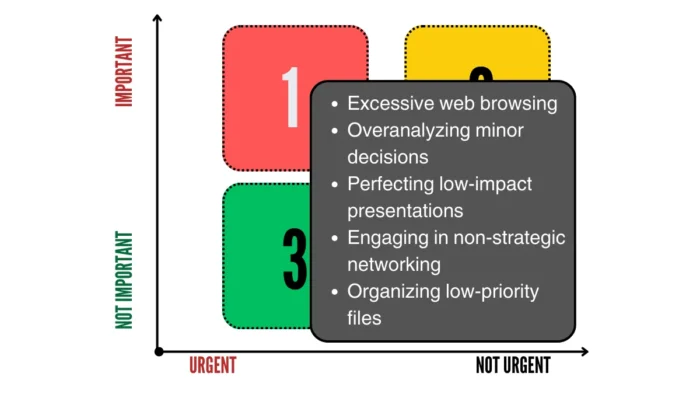
While these tasks might seem beneficial at the moment, they often do not directly contribute to achieving strategic goals or urgent responsibilities. By identifying activities that fall into Quadrant 4, you can more effectively manage your time by minimizing or eliminating these tasks altogether, allocating your most precious resource (time) to where it will impact your business most.
Now that you understand the four quadrants, it’s time to demonstrate how applying this framework to your daily routine can produce profound changes.
Benefits of Using the Time Management Matrix
Engaging with the Time Management Matrix isn’t just a way to categorize your to-dos or define task importance – it’s a strategy to develop a more fulfilling and effective approach to work and life.
The time management matrix helps you to:
Increase Productivity
By focusing on the first two quadrants, you focus on tasks that foster long-term growth. Effectively, this means you direct your time where it brings lasting rewards for your business or personal life.
Reduce Stress and Overwhelm
When you can distinguish between truly urgent tasks and those that are merely noisy, you can handle crises without letting them dictate your day. You’ll feel more in control and less at the mercy of a cluttered to-do list with all the tasks.
Improve Focus and Goal Achievement
The matrix improves your ability to prioritize and concentrate on what matters the most. You’ll find reaching significant, lifelong goals easier without being distracted by the inessential.
Develop Planning Skills
Through regular use of the matrix, you’ll improve your skillset in planning and strategy. This will, in turn, improve your long-term vision and make you a more effective leader.
Stay Organized
By systematically employing the matrix, you develop a sense of organization that translates into efficient management of all your resources, not just time.
Practical Strategies for Utilizing the Time Management Matrix
As you have seen, the matrix divides tasks into four different categories. But, applying the time management matrix is a strategic exercise. You need not just to assign tasks to quadrants but to act upon this categorization with tactical methods that turn theory into practice.
Prioritizing Tasks
Begin by assessing all your tasks and categorizing them. Give priority to the most crucial tasks from Quadrant 1 and begin to allocate time each week for Quadrant 2 activities, ensuring you keep them on your calendar or tasks list.
Delegating or Eliminating Tasks
You must be honest with what you can and should handle. Quadrant 3 tasks are often candidates for delegation because they are less crucial tasks. So, you must delegate tasks from this quadrant.
Conversely, time management quadrant four should ideally be removed from your schedule.
Time-Blocking Techniques
Segment your day into blocks of time, committing to work on just one quadrant at a time. This focused approach reduces decision-making stress during the day and increases your overall productivity.
Conclusion
The Time Management Matrix isn’t a panacea that will solve all of your time management woes overnight. It’s a tool – a very powerful one – that requires dedication and discipline. Investing time in understanding the matrix, identifying your tasks, and applying strategic methods of task management will change how you work, how you feel about work, and the outcomes you achieve.
As you can see, the time management matrix offers a process to prioritize the tasks on your tasks list, dividing tasks into four categories based on importance and urgency. This will give you tasks marked as 1 – something you need to do immediately, tasks marked as 2 – something that can be done soon, and tasks marked as 3 – something that needs to be done when you have free time or to be delegated. You will need to drop tasks marked with four from your list.
Proper time management is not only for entrepreneurs and managers; the same principles can be implemented in our personal lives. What is important is to always start with the right tasks.
It’s time to rethink how you approach your day and whether you’re aligning your time with your core priorities. Remember, while each passing minute is an opportunity, you must ensure that the opportunities align with your long-term vision. Your time is a limited resource – so manage it with purpose.


